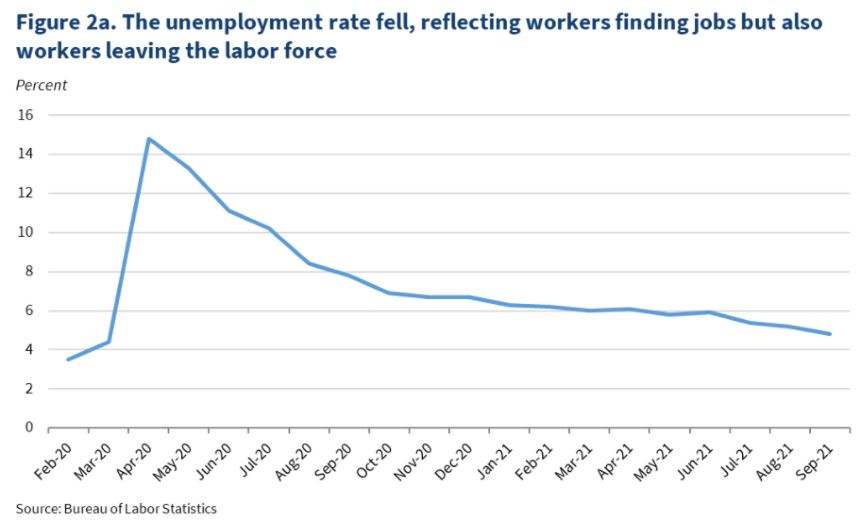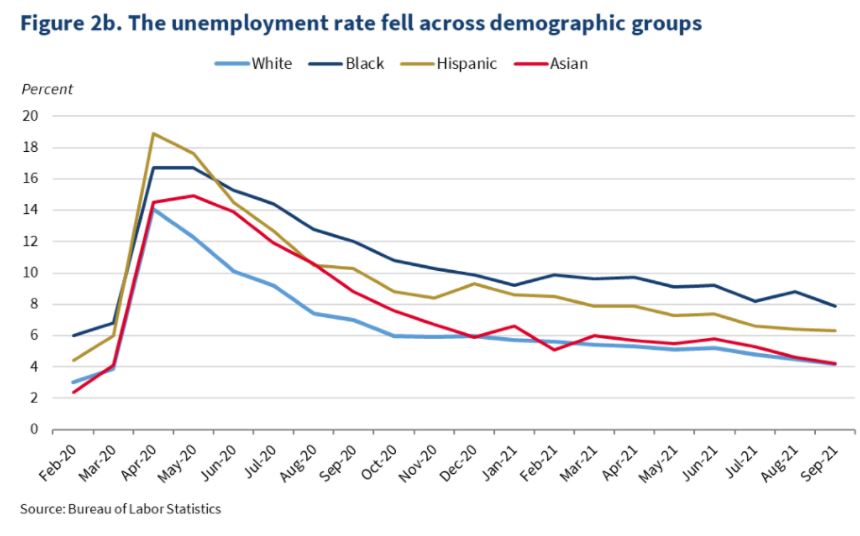The Employment Situation in September
By Chair Cecilia Rouse
We learned from today’s jobs report that the economy added 194,000 jobs in September, for an average monthly gain of 550,000 over the last three months. The number of jobs added in September came in below market expectations, as a resurgence of COVID and some unusual seasonal factors, especially in education, may have weighed on job growth. Job gains in July and August were revised up by a combined 169,000.
In addition, the unemployment rate fell by 0.4 percentage point to 4.8 percent as labor force participation ticked down and the employment rate reached a new pandemic recovery high. This is the lowest the unemployment rate has been since the pandemic began.
It is important to focus on the trend of data across multiple months, since any one month of data could be volatile. This report is also a reminder that the economic recovery will not be complete until the public health situation is under control, as reinforced by the continued number of COVID cases associated with the Delta variant.
1. Job growth over the last three months has averaged 550,000, a solid pace.
Average job growth from July to September was 550,000 jobs per month (see Figure 1), even as the pace slowed in August and September. Since monthly numbers can be volatile, it is important to focus on the three-month average rather than the data in a single month, as described in a recent CEA blog. The three-month average is likely to shift lower, however, once the October numbers come in, since the current three-month average includes very strong job growth in July.

Nevertheless, the labor market has not fully recovered: employment remains about 5 million jobs below its pre-pandemic level, or 3.3 percent lower.
2. Seasonal adjustment affected job growth, particularly in the education sector.
As the Council of Economic Advisers discussed last month and the month before, seasonal adjustment in education is particularly difficult to determine at the moment, as the school year has adjusted to address COVID concerns, and hiring seems to differ substantially from pre-pandemic patterns. As the Commissioner of the Bureau of Labor Statistics noted in a statement this morning: “Recent employment changes are challenging to interpret, as pandemic-related staffing fluctuations in public and private education have distorted the normal seasonal hiring and layoff patterns.”
Both private and public education added jobs on a not seasonally-adjusted basis in September, but not as many as expected. Once seasonally adjusted, this shortfall translates to a loss of 161,000 jobs in state and local education and 19,000 jobs in private educational services.
It continues to be unclear what state and local education job growth will look like in the months to come, reflecting both seasonal adjustment issues and dynamics with hiring and school operations.
3. The unemployment rate fell as some workers found jobs while others left the labor force.
The unemployment rate fell to 4.8 percent, its lowest rate in the pandemic, as seen in Figure 2a. The unemployment rate is impacted both by workers finding jobs, but also by workers choosing to stop looking for work (that is, leaving the labor force). The decline in the unemployment rate this month was due to both, as the employment-population ratio rose to 58.7 percent, a new high of the pandemic recovery, but the labor force participation rate ticked down to 61.6 percent. The labor force participation rate has remained between 61.6 and 61.7 percent since April 2021.

The Bureau of Labor Statistics (BLS) reported that the unemployment rate fell for all racial and ethnic groups that BLS reports, with the largest decline for Black workers (Figure 2b). As the Council of Economic Advisers has emphasized, demographic group breakdowns for the unemployment rate are often noisy month-to-month.
The Asian unemployment rate now matches the white unemployment rate. The smallest decline was for Hispanic workers, with a tick down of 0.1 percentage point in their unemployment rate. For white and Black workers, the declines reflected both employment gains and labor force departures.

4. The employment rate rose by 0.2 percentage point, largely reflecting younger and older people returning to work.
The employment rate ticked up to 58.7 percent, the highest it has been during the pandemic recovery. However, the employment rate for prime-aged workers age 25 to 54 held steady at its pandemic-recovery high from August. The increase in employment was concentrated among workers aged 16 to 24 and 55 and over (see Figure 3).

The increase in employment for workers age 55 and over may reflect some workers coming out of retirement. Retirements have remained elevated during the pandemic, largely due to workers staying in retirement rather than an elevated rate of entry into retirement.
The employment rate for workers age 55 and over remains 5 percent below its pre-pandemic level, while for workers, age 16 to 24 it is 3 percent below its pre-pandemic level.
5. Wage growth has been relatively high in recent months as employers look to hire.
Nominal wages rose again in September by 0.6 percent month-over-month. Over the last three months, nominal wages have risen at a 5 percent annualized rate (compared to about 3 percent pre-pandemic). The increase in wage growth has been concentrated among lower-paid workers, likely reflecting employers bidding up wages in an attempt to hire. Real wages, which adjust for inflation, fell between March 2021 and August 2021 (the last month for which we have inflation data). However, lower-paid workers (for instance in leisure and hospitality) who have experienced extremely large wage increases have seen their real wages rise.
Wage increases likely reflect temporary mismatch between labor supply and demand as the economy continues to work through the pandemic. Wage growth remains high in several sectors in which employers may have difficulty hiring at the moment (e.g. leisure and hospitality and transportation and warehousing); however, the rate of increase has slowed in recent months. (Figure 4).

As the Administration stresses every month, the monthly employment and unemployment figures can be volatile, and payroll employment estimates can be subject to substantial revision. Therefore, it is important not to read too much into any one monthly report, and it is informative to consider each report in the context of other data as they become available.

